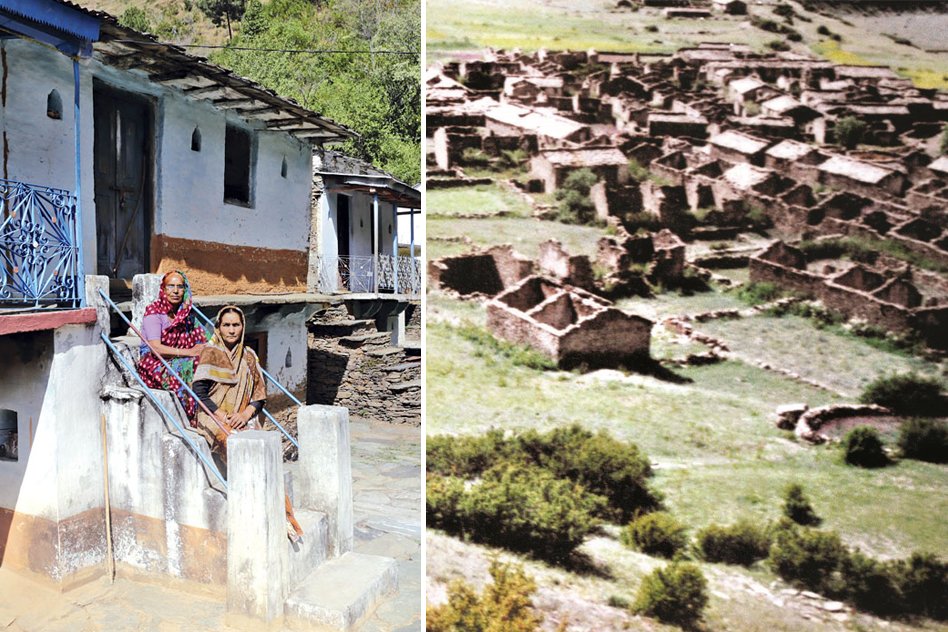
Image Courtesy: downtoearth | millenniumpost
The Migration Crisis Of Uttarakhand: 1053 Villages Have No Inhabitants
23 April 2016 10:17 AM GMT
The vicious cycle of migration threatens yet another state in India. Mass relocation, the very reason that led to the creation of Uttarakhand from the parent state of Uttar Pradesh, has been increasing at an alarming rate over the past few years. Villages in the hilly regions of the state are disappearing owing to movement of inhabitants towards urban plain lands with better opportunities. According to the census of 2011, out of Uttarakhand’s 16,793 villages, about 1,053 have no inhabitants. 405 of them have less than 10 occupants.
When a village is abandoned, it almost inevitably becomes rundown owing to degradation of land and resources that a community requires to thrive. Hence, revival for the unpopulated villages is next to impossible. Desire to earn more Since its inception Uttarakhand has done well on the economic growth front. But this growth has restricted itself to the three plain districts of the state. The ten hill districts are the ones left wanting with respect to the growth enjoyed by the state. Trying make a better livelihoods by pushing themselves into the labour force is almost natural amongst people living in the hill districts. According to a survey sponsored by the National Institute of Rural Development, about 88% of households in 18 sample villages in Pauri Garhwal and Almora districts had at least one member migrating for employment. 90% of the migrants are subject long-term or permanent relocation.
Nearly half the labourers in the agricultural sector could not fetch the minimum wage level despite the sector accounting for employment of over 70% of the rural workforce. With incomes this low, several families opted to take on the economic risk of educating their children and that marked the beginning of the migration story. Need for education Credit goes to the state government for improving education facilities for the state populace. Out of 5,852 km of roads that have been built between 2011 and 2015, almost 4,000 km have been built in rural areas, thereby improving access to primary education. There is at least one primary school for every two villages but the number of high schools would explain the mass migration in search of education. Once the student steps out for higher education the chances of returning is very low as they seldom find appropriate employment in the hill villages. “What outsiders fail to see is that villages are communities and work only as communities. If even a third of the village is gone, it becomes difficult for the rest to stay back and put the pieces back together,” says Pushpa Devi. Unused land The average land holding per farmer in the state is about 0.68 ha which is very less in comparison to the national average of 1.16 ha per farmer.
The small and divided nature of landholdings tends to make the agriculture industry unprofitable to say the least. Untended land also gives rise to problems as it gradually turns into unyielding infertile lands that the farmers cannot work with. Another factor that has caused problems to farming is the reluctance of land owners to lease their land out to the locals. They prefer to utilize the labour of Nepalese immigrants. For instance, Arjun Singh, a former labourer from Nepal has leased about 0.4 ha close to Pauri town at Rs 10,000 per year where he has been farming for the past three years. Health care- a necessity The younger members of the family having already migrated, the elderly who remain behind have to put up with the inefficient medical care at their disposal.
The lack of trained professionals and presence of referral hospitals in Dehradun and Nainital has caused a surge in migration to fulfil medical needs. Prowling animals, water shortages and depleting resources are among the many reasons for the mass migration the poses a threat to Uttarakhand. In a time when the Chief Minister, Harish Rawat, is caught up in his own struggle to defend his position, there is an urgent need to curb the migration crisis. He has spoken about a viable solution on several occasions in the recent past and it could well be the saving grace politically as well as economically for the state. On October 6th, the state government released a draft of a land bill to push for revitalisation of barren agricultural landholdings in the hills by consolidation small and scattered holdings. “The draft is a solid plan to arrest migration and encourage farming which is necessary in the state. We hope to use a carrot-and-stick policy to incentivise consent for consolidation,” says Anil Bahuguna, a veteran journalist and member of the drafting committee.
For the sake of Uttarakhand and its people, The Logical Indian hopes that the current bill works its magic to some extent. We also urge the state of Uttarakhand to undertake many more village revitalization projects to keep a check on migration levels.
 All section
All section













